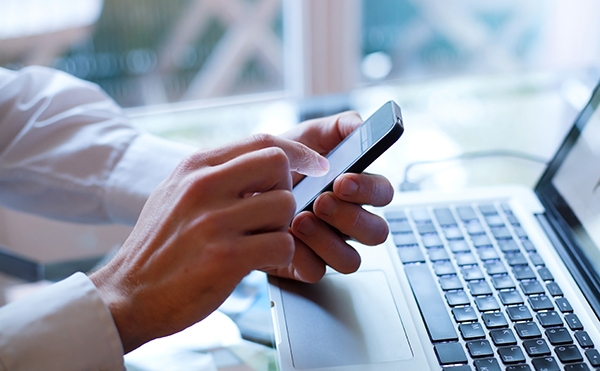HEALTH AND SAFETY
Bad posture and overuse of smartphones and other devices can cause unexpected health problems.
A recent British study of smartphone use showed that young adults checked their smartphones 85 times a day and used them for a total of five hours of use per day. The long-term effects of such constant smartphone use are not yet known but, if current studies and reports by the medical profession are any indication of the future, it would be advisable for all users to consider the impact smartphones and similar devices can have on their health.
In the Short Term
Text neck: a neck strain resulting from hunching over smartphones, tablets, or laptops for prolonged periods. Stress on the neck and upper back muscles causes pain because the body is subjected to an unnatural position for extended periods of time.
Computer vision syndrome (CVS): eye strain resulting from constant staring at small text or from scrolling through articles, messages or tweets. Common symptoms are dry eyes, blurred vision, headaches, and dizziness.
Phantom pocket vibration syndrome (“ringxiety”): the belief that your smartphone is vibrating when it is not. Studies show that some individuals may experience increased anxiety levels when they go an extended period without receiving a notification.
Nomophobia: (“no-mobile-phone-phobia”) is a term coined to describe the anxiety of individuals to be without a smartphone. Sufferers obsessively check to ensure the smartphone is present and constantly worry about misplacing it.
A recent study in the U.K. determined that 66% of the user population may suffer from this “ailment.” Symptoms include increased anxiety, which can manifest as a variety of physical symptoms including headaches, intestinal troubles, and muscle tension.
In addition to the more obvious outward physical pains and strains, there might even be a hidden tax on your health.
The Long Game
Medical specialists have determined that the poor posture caused, in part, by use of smartphones may cause excessive wear on the cervical spine (the neck) which can result in permanent degenerative changes including arthritis. The neck is designed to support the weight of your head (10 to 12 pounds) in an upright posture. Bending your head forward to text or read can place up to 60 pounds of stress on your neck muscles. This excess strain on your cervical spine over the years can increase the risk of cervical degeneration.
In addition to the more obvious outward physical pains and strains, there might even be a hidden tax on your health; when individuals use a smartphone, they tend to slump forward and curl their shoulders in toward their chest, thus restricting lung capacity. This, in turn, reduces oxygen intake and forces the heart to work harder to get oxygen to the brain. A lifetime of poor posture can have a negative impact on your cardiovascular health.
Preventing Injury
The best way to ensure these potential symptoms do not affect you is to stop using these devices completely. Since this is not possible, given our increasing dependence on technology, experts suggest the following may relieve symptoms and prevent long-term problems:
- Reduce eye strain by using larger fonts. Hold the device at least 16 inches from your face. Look up and away from the screen frequently. Scroll by page and not by line. Blink to ensure your eyes stay moist.
- During your next visit to a physician, physiotherapist, or chiropractor, ask about neck exercises you can do during work to help alleviate neck strain.
- If your wrists and hands feel sore or weak, try flexing your wrists or pushing down on a flat surface to stretch your fingers. If pain persists, talk to your doctor or physiotherapist.
- Improve your posture by evaluating the ergonomic setup of your work or home office. You can find an online self-assessment tool from the Ontario Ministry of Labour at: www.labour.gov.on.ca/english/hs/pubs/comp_erg
- Take regular and frequent stretch breaks (every 15 minutes or so), following the stretching guidelines provided by your doctor or physiotherapist. If you are prone to forget, set a reminder on your phone, computer or personal fitness tracker.
- If you have any of the symptoms associated with nomophobia or phantom pocket vibration, consider placing your device in a location more difficult to access when you’re not using it and scheduling specific times to check and respond to messages. For more serious symptoms, consider seeking professional counselling.
Be Tech-Strain Aware
Communication devices have provided benefits beyond our wildest expectations. While those benefits cannot be denied, they have brought with them other unforeseen issues that may have a long-term impact on personal health and welfare. Recognition of these issues should lead management and staff to work to prevent future personal health issues and to maintain the productivity of the entire workforce.
Contact Argento CPA today!
Source: BUSINESS MATTERS
Disclaimer: BUSINESS MATTERS deals with a number of complex issues in a concise manner; it is recommended that accounting, legal or other appropriate professional advice should be sought before acting upon any of the information contained therein.
Although every reasonable effort has been made to ensure the accuracy of the information contained in this letter, no individual or organization involved in either the preparation or distribution of this letter accepts any contractual, tortious, or any other form of liability for its contents or for any consequences arising from its use.
BUSINESS MATTERS is prepared bimonthly by the Chartered Professional Accountants of Canada for the clients of its members.
Richard Fulcher, CPA, CA – Author; Patricia Adamson, M.A., M.I.St. – CPA Canada Editor.
Contact us: patricia@adamsonwriters.ca


